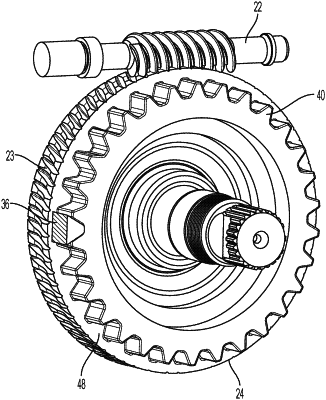| CPC B60R 25/0211 (2013.01) [B62D 5/001 (2013.01); F16H 1/16 (2013.01)] | 6 Claims |

|
1. A steering assist system of a steering column assembly comprising:
a worm rotatably driven by an actuator;
a worm gear having a first set of teeth at an outer diameter of a first portion of the worm gear and a second set of teeth at an outer diameter of a second portion of the worm gear, wherein the first set of teeth, the second set of teeth and the worm gear are a single, molded component, wherein the worm gear, the first set of teeth and the second set of teeth are formed of the same material, wherein the second portion of the worm gear protrudes from a first side of the first portion of the worm gear, the first set of teeth in meshed engagement with the worm, the worm gear operatively coupled to a steering shaft; and
a lock feature moveable into and out of engagement with the second set of teeth of the worm gear to define a locked condition and an unlocked condition of the worm gear,
wherein the second set of teeth extends circumferentially around the worm gear, the lock feature moveable into and out of engagement with the second set of teeth in a radial direction perpendicular to a longitudinal direction of the steering column assembly, wherein the lock feature is wedge shaped to correspond to a geometry of a recess between adjacent teeth of the second set of teeth of the worm gear, wherein the lock feature is disposed within the recess in the locked condition, the lock feature loaded with a spring in the locked condition to resist rotation of the worm gear, wherein a spring force of the spring and the angle of the second set of teeth resist a predetermined torque range applied to the worm gear, wherein a torque exceeding the predetermined torque range results in the lock feature to move to an adjacent recess of the second set of teeth.
|